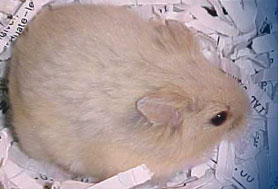

Dwarf Hamster Care
Basic Care:
| Housing | Bedding | Nesting Material | Cleaning | Exercise | Teeth | Food | Costs | Handling |
Advanced Care: Baby Care
|Things to Consider | Gender | Pairing | Housing | Baby Care | Campbells Dwarf Hamster Genetics |
|
Learn about how I socialize my baby dwarfs on the socializing baby page. Dwarf breeding info at a glance:
|
Baby CareBaby hamsters do not need much more care than adult dwarfs. From birth through 10 days, they should be left alone with mama. Do not change the cage or touch them. From 10 days on, you can change the cage weekly and handle the babies briefly if mama will allow it. Hold them over something soft like a tub of shredded paper because they are very jumpy until about 4 weeks of age and can be easily injured. If mom will not let you handle the babies, you can still tame them very well by handling them from weaning on (18 days). You can take the babies away from mom when she has another litter (roughly 20 days after the first if the male is still present) or, if she is not pregnant again, you can remove the babies and place them in their own cage(s) at 4 weeks of age. At 4 weeks they should be split by gender into same sex groups (males in one cage and females in another). This is to prevent unwanted babies, unwanted inbreeding and unwanted surprises for anyone adopting one of your female babies. From 10 days to 4 weeks of age, the babies should get a good portion of oats, oatmeal, wheat germ or small birdseeds. They can eat lab blocks from 3 weeks on but will not thrive on them until older. They grow much more quickly if offered small grains. You can also offer slices of cucumber or red apple from 10 days of age until the babies can reach the water bottle. This prevents dehydration and mama naturally starts to nurse them less. Babies should not be sold or given away until they are 4 weeks of age. All pictures on this site are copyrighted by Odds and Endlers. Any unauthorized use is strictly prohibited. |
